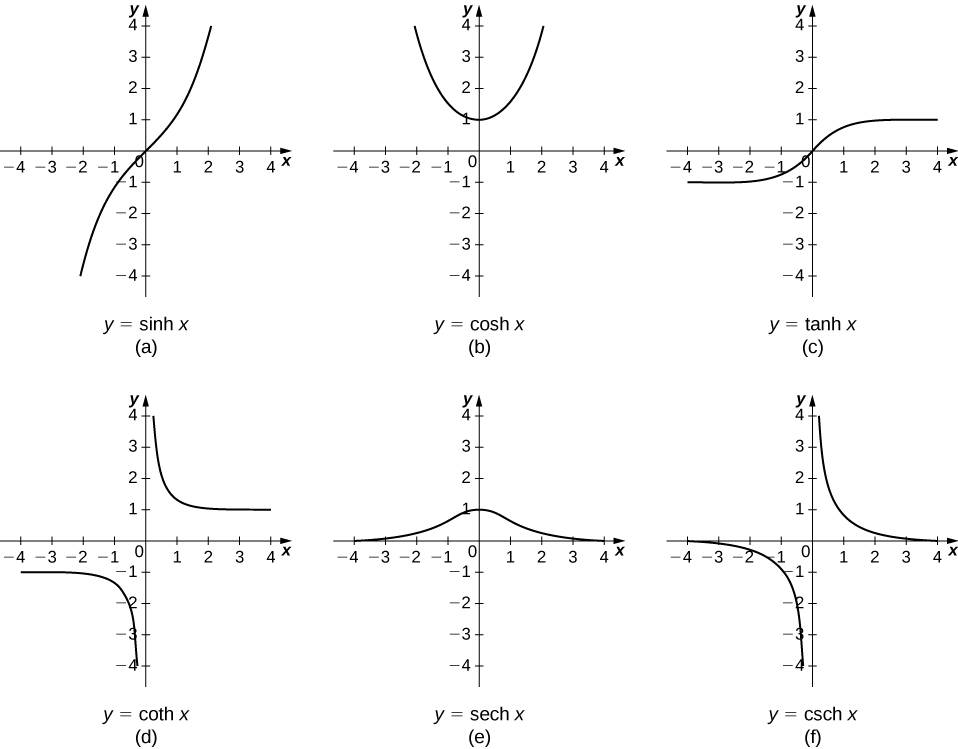
Recall that the hyperbolic sine and hyperbolic cosine are defined as
[latex]\textThe other hyperbolic functions are then defined in terms of [latex]\textx[/latex] and [latex]\textx.[/latex] The graphs of the hyperbolic functions are shown in the following figure.

Figure 1. Graphs of the hyperbolic functions.
It is easy to develop differentiation formulas for the hyperbolic functions. For example, looking at [latex]\textx[/latex] we have
Similarly, [latex](\frac)\textx=\textx.[/latex] We summarize the differentiation formulas for the hyperbolic functions in the following table.
| [latex]f(x)[/latex] | [latex]\fracf(x)[/latex] |
|---|---|
| [latex]\textx[/latex] | [latex]\textx[/latex] |
| [latex]\textx[/latex] | [latex]\textx[/latex] |
| [latex]\textx[/latex] | [latex]>^x[/latex] |
| [latex]\textx[/latex] | [latex]\text>^x[/latex] |
| [latex]\textx[/latex] | [latex]\text\textx\textx[/latex] |
| [latex]\textx[/latex] | [latex]\text\textx\textx[/latex] |
Let’s take a moment to compare the derivatives of the hyperbolic functions with the derivatives of the standard trigonometric functions. There are a lot of similarities, but differences as well. For example, the derivatives of the sine functions match: [latex](\frac) \sin x= \cos x[/latex] and [latex](\frac)\textx=\textx.[/latex] The derivatives of the cosine functions, however, differ in sign: [latex](\frac) \cos x=\text \sin x,[/latex] but [latex](\frac)\textx=\textx.[/latex] As we continue our examination of the hyperbolic functions, we must be mindful of their similarities and differences to the standard trigonometric functions.
These differentiation formulas for the hyperbolic functions lead directly to the following integral formulas.
[latex]\begin
Evaluate the following derivatives:
Show SolutionUsing the formulas in the table on derivatives of the hyperbolic functions and the chain rule, we get
Evaluate the following derivatives:
Show SolutionUse the formulas in the last example and apply the chain rule as necessary.
Watch the following video to see the worked solution to Example: Differentiating Hyperbolic Functions and the above Try It.
Closed Captioning and Transcript Information for VideoFor closed captioning, open the video on its original page by clicking the Youtube logo in the lower right-hand corner of the video display. In YouTube, the video will begin at the same starting point as this clip, but will continue playing until the very end.
Evaluate the following integrals:
We can use [latex]u[/latex]-substitution in both cases.
[latex]\displaystyle\int \text
Note that [latex]\text
Evaluate the following integrals:
Use the formulas above and apply [latex]u[/latex]-substitution as necessary.
Watch the following video to see the worked solution to the above Try It.
Closed Captioning and Transcript Information for VideoFor closed captioning, open the video on its original page by clicking the Youtube logo in the lower right-hand corner of the video display. In YouTube, the video will begin at the same starting point as this clip, but will continue playing until the very end.
Looking at the graphs of the hyperbolic functions, we see that with appropriate range restrictions, they all have inverses. Most of the necessary range restrictions can be discerned by close examination of the graphs. The domains and ranges of the inverse hyperbolic functions are summarized in the following table.
| Function | Domain | Range |
|---|---|---|
| [latex]>^x[/latex] | [latex](\text\infty ,\infty )[/latex] | [latex](\text\infty ,\infty )[/latex] |
| [latex]>^x[/latex] | [latex](1,\infty )[/latex] | [latex][0,\infty )[/latex] |
| [latex]>^x[/latex] | [latex](-1,1)[/latex] | [latex](\text\infty ,\infty )[/latex] |
| [latex]>^x[/latex] | [latex](\text\infty ,-1)\cup (1,\infty )[/latex] | [latex](\text\infty ,0)\cup (0,\infty )[/latex] |
| [latex]>^x[/latex] | [latex](0\text)[/latex] | [latex][0,\infty )[/latex] |
| [latex]>^x[/latex] | [latex](\text\infty ,0)\cup (0,\infty )[/latex] | [latex](\text\infty ,0)\cup (0,\infty )[/latex] |
The graphs of the inverse hyperbolic functions are shown in the following figure.

Figure 2. Graphs of the inverse hyperbolic functions.
To find the derivatives of the inverse functions, we use implicit differentiation. We have
[latex]\begin
We can derive differentiation formulas for the other inverse hyperbolic functions in a similar fashion. These differentiation formulas are summarized in the following table.
| [latex]f(x)[/latex] | [latex]\fracf(x)[/latex] |
|---|---|
| [latex]>^x[/latex] | [latex]\frac^>>[/latex] |
| [latex]>^x[/latex] | [latex]\frac^-1>>[/latex] |
| [latex]>^x[/latex] | [latex]\frac^>[/latex] |
| [latex]>^x[/latex] | [latex]\frac^>[/latex] |
| [latex]>^x[/latex] | [latex]\frac |
| [latex]>^x[/latex] | [latex]\frac<|x|\sqrt<1+ |
Note that the derivatives of [latex]>^x[/latex] and [latex]>^x[/latex] are the same. Thus, when we integrate [latex]1\text(1-^),[/latex] we need to select the proper antiderivative based on the domain of the functions and the values of [latex]x.[/latex] Integration formulas involving the inverse hyperbolic functions are summarized as follows.
Evaluate the following derivatives:
Show SolutionUsing the formulas in the table on derivatives of the inverse hyperbolic functions and the chain rule, we obtain the following results:
Evaluate the following derivatives:
Show SolutionUse the formulas in the table on derivatives of the inverse hyperbolic functions above and apply the chain rule as necessary.
Watch the following video to see the worked solution to the above Try It.
Closed Captioning and Transcript Information for VideoFor closed captioning, open the video on its original page by clicking the Youtube logo in the lower right-hand corner of the video display. In YouTube, the video will begin at the same starting point as this clip, but will continue playing until the very end.
Evaluate the following integrals:
We can use [latex]u\text[/latex] in both cases.
Evaluate the following integrals:
Use the formulas above and apply [latex]u\text[/latex] as necessary.
Watch the following video to see the worked solution to the above Try It.
Closed Captioning and Transcript Information for VideoFor closed captioning, open the video on its original page by clicking the Youtube logo in the lower right-hand corner of the video display. In YouTube, the video will begin at the same starting point as this clip, but will continue playing until the very end.